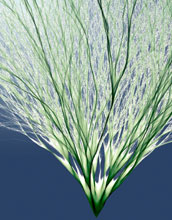Multimedia Gallery
Transport IV
Transport IV
"Transport IV," from the Gallery of Eric J. Heller. Explanation of image, as taken from Heller Gallery: The Transport series renders electron flow paths in a "two dimensional electron gas" (2DEG), Inspired by the experiments of Mark Topinka, Brian Leroy, and professor Robert Westervelt at Harvard.
Our group was responsible for the theoretical treatment of the problem, primarily Scot Shaw, and myself. Transport VI is based on the actual electron flow patterns for electrons riding over a bumpy landscape, which is what they encounter in the 2DEG. The electrons have more than enough energy to ride over any bump in the landscape, and the concentrations of electron flow seen here are unexpected indirect effects of that bumpy ride. The channeling or branching was a surprise and has serious implications for small electronic devices of the future. Transport VI is an excellent example of the wonderful way nature emulates herself in different contexts. Thus, the folding of the electron trajectories is like looking through translucent kelp, or like ridges on a mountain.
Heller's work was included in the exhibit "Approaching Chaos," shown at the National Science Foundation (NSF) headquarters in Arlington, Va., July thru October 2002, as part of "The Art of Science Project." The Art of Science Project was conceived and implemented by a cross-directorate committee of NSF staff. Its purpose is to bring to NSF, original works of art that visually explore the connections between artistic and scientific expression.
This image is copyright and was included in the NSF Multimedia Gallery with permission from the owner. See "Restrictions" below regarding use of this image. [Research supported by Harvard's NSEC (NSF) grant.] (Date of Image: 2001)
Credit: Eric J. Heller, Harvard University
Special Restrictions: Copyright 2001 Eric J. Heller; not for publication without permission of author. Contact at mailto:slheller@comcast.net.
Images and other media in the National Science Foundation Multimedia Gallery are available for use in print and electronic material by NSF employees, members of the media, university staff, teachers and the general public. All media in the gallery are intended for personal, educational and nonprofit/non-commercial use only.
Images credited to the National Science Foundation, a federal agency, are in the public domain. The images were created by employees of the United States Government as part of their official duties or prepared by contractors as "works for hire" for NSF. You may freely use NSF-credited images and, at your discretion, credit NSF with a "Courtesy: National Science Foundation" notation.
Additional information about general usage can be found in Conditions.
Also Available:
Download the high-resolution JPG version of the image. (1.7 MB)
Use your mouse to right-click (Mac users may need to Ctrl-click) the link above and choose the option that will save the file or target to your computer.



